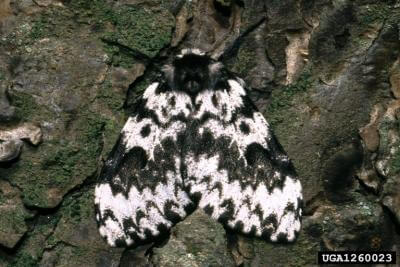
The black-arched tussock moth, formerly named Eurasian nun moth, is in the same genus (Lymantria) as the spongy moth, and is similar in host utilization and behavior. The host range is wide, consisting of conifer and hardwood species. Black-arched tussock moth cause more damage in continental Europe than any other forest defoliator, including the spongy moths. The Siberian risk assessment (USDA Forest Service, 1991) stated that if the black-arched tussock moth would become established, 172 million acres could be affected in the United States. Entry potential is considered to be high, as black-arched tussock moth females can lay egg masses in crevasses ranging from pallets to ship structures. Extensive research has been conducted on detection and biological control of this potential pest if it is introduced into North America (Morewood et al., 2000; Gries et al., 2001; Fuester et al., 2001).
USFS scientists and managers developed a conservation priority-setting framework for forest tree species at risk from pest & pathogens and other threats. The Project CAPTURE (Conservation Assessment and Prioritization of Forest Trees Under Risk of Extirpation) uses FIA data and expert opinion to group tree species under threat by non-native pests into vulnerability classes and specify appropriate management and conservation strategies. The scientists prioritized 419 tree species native to the North American continent. The analysis identified 15 taxonomic groups requiring the most immediate conservation intervention because of the tree species’ exposure to an extrinsic threat, their sensitivity to the threat, and their ability to adapt to it. Each of these 15 most vulnerable species, and several additional species, should be the focus of both a comprehensive gene conservation program and a genetic resistance screening and development effort. Black-arched tussock moth is not known to be a threat to any of these 15 most vulnerable species.
Sources
Fuester, R. W., M. Kenis, K. S. Swan, P. C. Kingsley, C. Lopez-Vaamonde, and F. Herard. 2001. Host range of Aphantorhaphopsis samarensis (Dipetera: Tachinidae), a larval parasite of the gypsy moth (Lepidoptera: Lymantriidae). Environ. Entomol. 30: 605-611.
Gries, G., P. W. Schaefer, R. Gries, J. Liska, and T. Gotoh. 2001. Reproductive character displacement in Lymantria monacha from northern Japan. J. Chem.. Ecol. 27: 1163-1176.
Morewood, P., G. Gries, J. Liska, P. Kapitola, D. Haussler, K. Moller, and H. Bogenschutz. 2000. Towards pheromone-based montioring of nun moth, Lymantria monacha (L.) (Lep., Lymantriidae) populations. J. Appl. Entomol. 124: 77-85.
Potter, K.M., Escanferla, M.E., Jetton, R.M., Man, G., Crane, B.S., Prioritizing the conservation needs of US tree spp: Evaluating vulnerability to forest insect and disease threats, Global Ecology and Conservation (2019), doi: https://doi.org/10.1016/
United States Department of Agriculture Forest Service. 1991. Pest Risk Assessment of the Importation of Larch from Siberia and the Soviet Far East, Miscellaneous Publication No. 1495, September, 1991.



